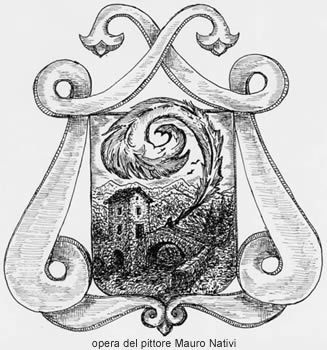"Gli Appennini sono per me un pezzo meraviglioso del creato. Alla grande pianura della regione padana segue una catena di monti che si eleva
dal basso per chiudere verso sud il continente tra due mari (....) è un così bizzarro groviglio di pareti montuose a ridosso l'una dall'altra;
spesso non si può nemmeno distinguere in che direzione scorre l'acqua."
J. W. Goethe, Viaggio in Italia (1786 - 1788)
J. W. Goethe, Viaggio in Italia (1786 - 1788)
Bruscoli
The Castle of Bruscoli has undergone afterwards to partial modifications: around the middle of the XVI century, with the development of the powerful gunpowder, was erected the Cannoniera, which connected with an alley the different guns..
The strategic importance of the Bruscoli fortress is evidenced by the presence of a look-out tower near Roncobilaccio, one in Civitella and from the visual dominance of the Gambellato, tributary of the river Setta.
Is interesting to note that we find the name-place of Poggio della Guardia (Hillock of thhe Guard) in the slope of Piano and the Guardingo in the Tuscany one, both of them as testimonies of two positions of defenceand control of the territory.
Other than having been the main residence of the counts Albertidi Bruscolo, this fortress was centre of the homonymous vicariate. This territorial institution was constituted in1376 and lasted until 1384. ( In 1393 the territory and Castel di Piano were conceeded in emphyteusis to the cavalier Petruzzo de Banchi).
The communities subjected to the vicariate of Bruscoli were: Bruscolo, Piliano and Barigazza.
In 1380, the count Alberto degli Alberti left, for money, his feudal properties to the common of Bologna.
An administrative document mentions that in 1384 the vicar made execute some works for the reparation of the roof of this fortress. Then, there are no other news about this vicariate till 1454, when in the statutes of the city of Bologna was riconfirmed its jurisdiction with the exception of the territory of Piano, still in the hand of the noble Florentine house of the De Bianchi.
The figure of the vicar kept in itself also theone of Captain of the fortress and so this man carried on also the military custody of this castle.
Many stones of this ancient fort were transferred in town and used as precious material for construction and building of different civil houses.
Writtenby Maurizio Valentini and present in the review “Due passi nella storia” created by the Centro di Documentazione Pianese and patronized by the Group of Studies Savena Setta Sambro.
On the top of the San Martino Poggio (hillock), some recent excavating campaigns have brought to light a part of the rooms of the castle of Bruscoli. This was a typical fortress with practically only military function. It had a particular wedge planimetry, that made it absolutely strong and unattackable.
The existence of this fortress is testified by the Imperial Diploma of Federico, known as the Barbarossa, who, in 1164, counts this land under the feudal dependance of the counts Alberti of Mangone.The Castle of Bruscoli has undergone afterwards to partial modifications: around the middle of the XVI century, with the development of the powerful gunpowder, was erected the Cannoniera, which connected with an alley the different guns..
The strategic importance of the Bruscoli fortress is evidenced by the presence of a look-out tower near Roncobilaccio, one in Civitella and from the visual dominance of the Gambellato, tributary of the river Setta.
Is interesting to note that we find the name-place of Poggio della Guardia (Hillock of thhe Guard) in the slope of Piano and the Guardingo in the Tuscany one, both of them as testimonies of two positions of defenceand control of the territory.
Other than having been the main residence of the counts Albertidi Bruscolo, this fortress was centre of the homonymous vicariate. This territorial institution was constituted in1376 and lasted until 1384. ( In 1393 the territory and Castel di Piano were conceeded in emphyteusis to the cavalier Petruzzo de Banchi).
The communities subjected to the vicariate of Bruscoli were: Bruscolo, Piliano and Barigazza.
In 1380, the count Alberto degli Alberti left, for money, his feudal properties to the common of Bologna.
An administrative document mentions that in 1384 the vicar made execute some works for the reparation of the roof of this fortress. Then, there are no other news about this vicariate till 1454, when in the statutes of the city of Bologna was riconfirmed its jurisdiction with the exception of the territory of Piano, still in the hand of the noble Florentine house of the De Bianchi.
The figure of the vicar kept in itself also theone of Captain of the fortress and so this man carried on also the military custody of this castle.
Many stones of this ancient fort were transferred in town and used as precious material for construction and building of different civil houses.
Writtenby Maurizio Valentini and present in the review “Due passi nella storia” created by the Centro di Documentazione Pianese and patronized by the Group of Studies Savena Setta Sambro.




